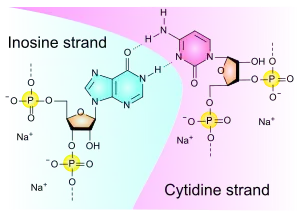Polyinosinic:polycytidylic acid
Polyinosinic:polycytidylic acid (usually abbreviated poly I:C or poly(I:C)) is an immunostimulant. It is used in the form of its sodium salt to simulate viral infections.[1]
 | |
| Clinical data | |
|---|---|
| ATC code | |
| Identifiers | |
| |
| CAS Number | |
| PubChem CID | |
| ChemSpider |
|
| UNII | |
| CompTox Dashboard (EPA) | |
| Chemical and physical data | |
| Formula | (C10H10N4NaO7P)x • (C9H11N3NaO7P)x |
| | |
Poly I:C is known to interact with toll-like receptor 3 (TLR3), which is expressed at the endosomal membrane of B-cells, macrophages and dendritic cells. Poly I:C is structurally similar to double-stranded RNA, which is present in some viruses and is a "natural" stimulant of TLR3. Thus, Poly I:C can be considered a synthetic analog of double-stranded RNA and is a common tool for scientific research on the immune system.[2]
Chemistry
Poly I:C is a mismatched double-stranded RNA with one strand being a polymer of inosinic acid, the other a polymer of cytidylic acid.
Variants
Optimization of physicochemical properties of poly I:C has led to generation of derivatives that have increased stability in body fluids (such as polyICLC), or reduced toxicity through reduced stability in body fluids (such as poly I:C12U).[3]
References
- Fortier ME, Kent S, Ashdown H, Poole S, Boksa P, Luheshi GN (October 2004). "The viral mimic, polyinosinic:polycytidylic acid, induces fever in rats via an interleukin-1-dependent mechanism". American Journal of Physiology. Regulatory, Integrative and Comparative Physiology. 287 (4): R759–R766. doi:10.1152/ajpregu.00293.2004. PMID 15205185. S2CID 24028101.
- Li Y, Xu XL, Zhao D, Pan LN, Huang CW, Guo LJ, et al. (November 2015). "TLR3 ligand Poly IC Attenuates Reactive Astrogliosis and Improves Recovery of Rats after Focal Cerebral Ischemia". CNS Neuroscience & Therapeutics. 21 (11): 905–913. doi:10.1111/cns.12469. PMC 4638223. PMID 26494128.
- Naumann K, Wehner R, Schwarze A, Petzold C, Schmitz M, Rohayem J (2013-12-02). "Activation of dendritic cells by the novel Toll-like receptor 3 agonist RGC100". Clinical & Developmental Immunology. 2013: 283649. doi:10.1155/2013/283649. PMC 3878805. PMID 24454470.